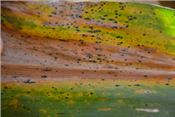2016 Tar Spot Again Found On Corn In Northern Illinois
DR. SUZANNE BISSONNETTE
URBANA, ILL.
Corn leaf samples from LaSalle county have been positively identified by the University of Illinois Plant Clinic to be infected with Tar Spot Phyllachora maydis. Commercial Agriculture Extension Educator Russ Higgins found the disease while field scouting. The fungal leaf blight was identified in numerous northern Illinois and northern Indiana counties in 2015.
Tar Spot has distinctive signs and symptoms. The fungal fruiting body, called an ascomata, looks like an actual spot of tar on the leaf. Lesions are black, oval to circular. They can be small flecks of about 1/64” up to about 5/64”. The lesions can merge together to produce an affected area up to 3/8”. If you run your finger across the leaf you will feel tiny bumps.
Prior to 2015, Tar Spot was known to occur only in cool humid areas at high elevations in Latin America. Tar Spot can form a complex with another fungus. The 2 fungi that cause ‘Tar Spot disease complex’ on corn are Phyllachora maydis and Monographella maydis. When Monographella maydis is in association with Phyllachora maydis the complex has been demonstrated to cause economic yield losses in Latin America. Phyllachora maydis alone is not known to significantly reduce yield. When the two are in combination a distinctive symptom is seen. The black Tar Spot will be surrounded by a tan lesion so the two together resemble a ‘fish-eye’.
Other pathogens may be confused with Tar Spot, especially the overwintering teliospore (black) phase of corn rust. Also, there are many fungi, called saprophytes that feed on dead corn tissue and form black splotches on the leaves.
To date only one of the pathogens, Phyllachora maydis, has been found in IL in 2015 and 2016, and IN in 2015. If you suspect Tar Spot please submit a sample to The University of Illinois Plant Clinic. We are cooperating with USDA-APHIS-CAPS to get a comprehensive idea of distribution in the state. Illinois producers can participate at no cost, see how at this link https://uofi.box.com/s/bizu6oz3re35v9boif784nz4zvy85gjc ∆
DR. SUZANNE BISSONNETTE: Assistant Dean, Agriculture and Natural Resources, University of Illinois

Picture 1. Distinctive black fruiting bodies of
Tar Spot on corn leaf 2016.
Photo courtesy of Russ Higgins, University of Illinois Extension